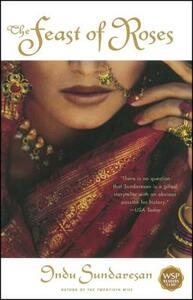You need to sign in or sign up before continuing.
Take a photo of a barcode or cover
challenging
emotional
informative
inspiring
reflective
tense
medium-paced
Strong character development:
Yes
Loveable characters:
Complicated
Diverse cast of characters:
Yes
Flaws of characters a main focus:
Yes
Excellent book. Didn’t quite hit me enough to be 5 stars but nonetheless excellent. It does a great job showing the depth and beauty of Mughal court in the 17th c and the complex relations and politics within the royal family as well as internationally.
Another magnificent book by Indu Sundaresan. If you have read my review of the first book, 'The twentieth wife', of 'The Taj Mahal Trilogy', you'll know that I loved it. I loved the second part even more.
There is a characteristic style of writing of the author which entails vivid descriptions of scenes of life and times of the Mughal era ; the palaces, the gardens, the women, the royalties and the riches, the cuisines and the customs; everything woven in a gripping tale of love, power and politics makes it a fascinating read.
The story begins from where we left off on the first book, that is after Mehrunissa marries Jahangir to become his twentieth wife. However, she is constantly driven by her ambitions to become something more than just a Mughal emperor's wife, one of the many ladies of his harem. Nur Jahan- the title bestowed upon her by Jahangir, steadily grew her strong hold not just within the palace walls but across the empire. She became the first mughal woman to have made a mark in history as she ruled alongside Jahangir and took decisions on his behalf for the empire, to become the much talked about 'empress who ruled from behind the veil and directly influenced Jahangir'. In the 16th century, when roles of women were clearly demarcated, she, with her charm and intelligence was able to influence Jahangir and thus gained a position of power in the Mughal court.
The story captures her rise to power, along with the relationship dynamics with people around her; Jahangir, ladies of the harem, her brother, father and daughter and members of the Mughal court.
Also, it includes the story of the rise of Jahangir's son, Shah Jahan, how he transformed from a prince to become the fifth mughal king of India, how Mehrunissa was instrumental in triggering a chain of events that directly impacted what could and could not become of Shah Jahan and altered the course of history.
It also entails the first footings of the western forces, Portuguese and English in India, what they set out for and what they achieved and how was the trade done in Jahangir's reign.
The writing has done justice to the tales of one of the greatest Mughal emperor's regime. All in all, a great read!
There is a characteristic style of writing of the author which entails vivid descriptions of scenes of life and times of the Mughal era ; the palaces, the gardens, the women, the royalties and the riches, the cuisines and the customs; everything woven in a gripping tale of love, power and politics makes it a fascinating read.
The story begins from where we left off on the first book, that is after Mehrunissa marries Jahangir to become his twentieth wife. However, she is constantly driven by her ambitions to become something more than just a Mughal emperor's wife, one of the many ladies of his harem. Nur Jahan- the title bestowed upon her by Jahangir, steadily grew her strong hold not just within the palace walls but across the empire. She became the first mughal woman to have made a mark in history as she ruled alongside Jahangir and took decisions on his behalf for the empire, to become the much talked about 'empress who ruled from behind the veil and directly influenced Jahangir'. In the 16th century, when roles of women were clearly demarcated, she, with her charm and intelligence was able to influence Jahangir and thus gained a position of power in the Mughal court.
The story captures her rise to power, along with the relationship dynamics with people around her; Jahangir, ladies of the harem, her brother, father and daughter and members of the Mughal court.
Also, it includes the story of the rise of Jahangir's son, Shah Jahan, how he transformed from a prince to become the fifth mughal king of India, how Mehrunissa was instrumental in triggering a chain of events that directly impacted what could and could not become of Shah Jahan and altered the course of history.
It also entails the first footings of the western forces, Portuguese and English in India, what they set out for and what they achieved and how was the trade done in Jahangir's reign.
The writing has done justice to the tales of one of the greatest Mughal emperor's regime. All in all, a great read!
